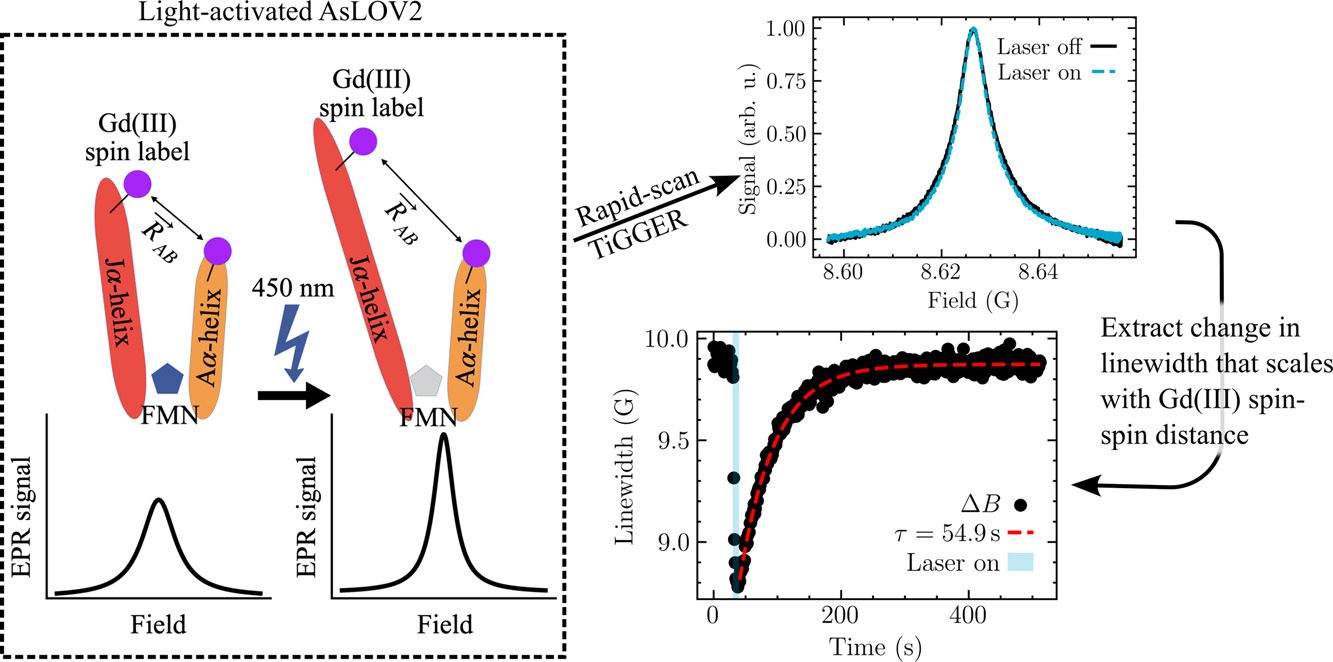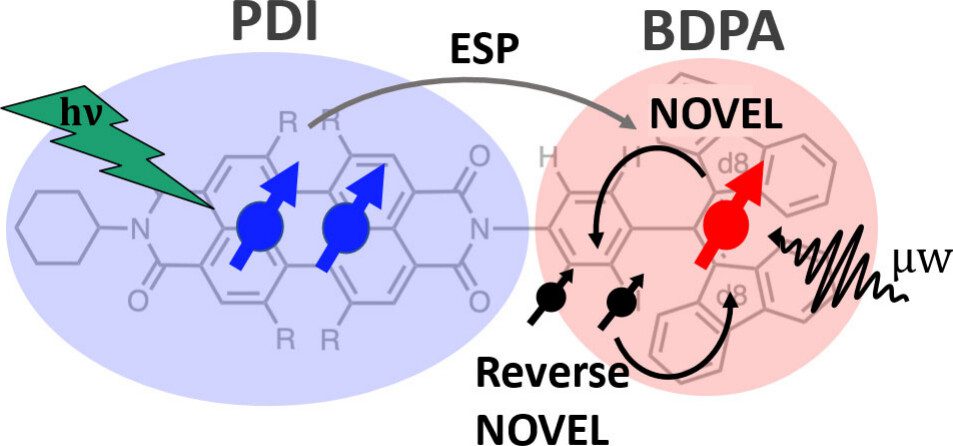Design spin cluster for NMR signal amplification and quantum resonance sensing
To reveal “invisible” NMR signal of surfaces, active sites, and functional species in catalysis, molecular recognition and quantum materials using out of the box tools.
The Han lab pushes the frontier of magnetic resonance to discover new chemistry principles in water and through control over the shaping and ordering of dynamic water. We use advanced magnetic resonance manipulation and control over the spatial organization of electron and nuclear spin clusters located on biomolecular surface, soft materials or nanomaterials to uncover their structure, the design rules for molecular recognition, and the surface structuring and dynamics of hydration water.
The development effort requires multiple research tools in the realm of physical chemistry broadly speaking. They include instrument development to achieve hyperpolarization and quantum resonance sensing, the design of precisely tuned electron and nuclear spin clusters, spin physic theory and simulations, and the dynamics and thermodynamics of solvation science to control biomolecular activity and directed assembly.
The Han lab is pushing the frontier of electron and nuclear spin magnetic resonance instrumentation and concepts in dynamic nuclear polarization (DNP) amplified nuclear magnetic resonance (NMR) and electron paramagnetic resonance (EPR). We are motivated by the power of “Seeing is Believing”. Visualizing molecular interactions and materials interfaces, previously “invisible”, can fundamentally transform our ability to discover solutions, and almost as importantly, ask new questions.

Research in the Han Lab builds and employs state-of-the-art tools in magnetic resonance spectroscopy to advance our understanding in different subject areas, ranging from quantum sensing, solvation science, biophysics to neurodegenerative diseases.
SEE ALL RESEARCHTo reveal “invisible” NMR signal of surfaces, active sites, and functional species in catalysis, molecular recognition and quantum materials using out of the box tools.
To understand, control and engineer protein aggregation pathways, protein surface activity to protein liquid-liquid phase separation.
To reveal long-standing questions on the structure and dynamics of water on proteins, membranes to catalyst support surfaces.

We present field-domain rapid-scan (RS) electron paramagnetic resonance (EPR) at 8.6 T and 240 GHz. To enable this technique, we upgraded a homebuilt EPR spectrometer with an FPGA-enabled digitizer and real-time processing software. The software leverages the Hilbert transform to recover the in-phase (𝐼) and quadrature (𝑄) channels, and therefore the raw absorptive and dispersive signals, 𝜒′ and 𝜒′′, from their combined magnitude (√𝐼2+𝑄2). Averaging a magnitude is simpler than real-time coherent averaging and has the added benefit of permitting long-timescale signal averaging (up to at least 2.5 × 106 scans) because it eliminates the effects of sourcereceiver phase drift. Our rapid-scan (RS) EPR provides a signal-to-noise ratio that is approximately twice that of continuous wave (CW) EPR under the same experimental conditions, after scaling by the square root of acquisition time. We apply our RS EPR as an extension of the recently reported time-resolved Gd-Gd EPR (TiGGER) [Maity et al., 2023], which is able to monitor inter-residue distance changes during the photocycle of a photoresponsive protein through changes in the Gd-Gd dipolar couplings. RS, opposed to CW, returns field-swept spectra as a function of time with 10 ms time resolution, and thus, adds a second dimension to the static field transients recorded by TiGGER. We were able to use RS TiGGER to track time-dependent and temperature-dependent kinetics of AsLOV2, a light-activated phototropin domain found in oats. The results presented here combine the benefits of RS EPR with the improved spectral resolution and sensitivity of Gd chelates at high magnetic fields. In the future, field-domain RS EPR at high magnetic fields may enable studies of other real-time kinetic processes with time resolutions that are otherwise difficult to access in the solution state.

Chromophore radicals (CR) are emerging as important components for molecular quantum information science (QIS), especially in the context of quantum sensing. Here, we demonstrate that the optically hyperpolarized electrons in a 1,6,7,12-tetrakis(4-tert-butylphenoxy)-perylene-3,4,9,10-bis(dicarboximide) (tpPDI) covalently linked to a partially deuterated 1,3-bis(diphenylene)-d16-2-phenylallyl radical (BDPA-d16) can be coherently manipulated via pulsed dynamic nuclear polarization (DNP) methods to transfer polarization to nuclear spins and back. Under light illumination at 85 K, electron hyperpolarization in BDPA is enhanced 2.1- to 2.4-fold over thermal polarization and lasts for more than 100 ms. By applying nuclear orientation via electron spin-locking (NOVEL) DNP, this optically amplified electron hyperpolarization was successfully transferred to a 1H nuclear spin within the CR system and efficiently returned to the electron spin for readout via reverse-NOVEL. The NOVEL transfer efficiency of 65% amounts to a 688-fold nuclear spin hyperpolarization of the target nuclear spin, considering the 2.1-fold electron spin hyperpolarization. This reversible coherent manipulation of hyperpolarization transfer highlights the utility of CR systems to initialize and read out nuclear spin states in a disordered matrix at moderate cryogenic temperatures. Coupled with CRs’ environmental compatibility, tunability, and precise state initialization, these results highlight the promising role of nuclear spins in CRs for QIS applications, including quantum sensing and memory.
A critical discovery of the past decade is that tau protein fibrils adopt disease-specific hallmark structures in each tauopathy. The faithful generation of synthetic fibrils adopting hallmark structures that can serve as targets for developing diagnostic and/or therapeutic strategies remains a grand challenge. We report on a rational design of synthetic fibrils built of a short peptide that adopts a critical structural motif in tauopathy fibrils found in Alzheimer’s Disease (AD) and Chronic Traumatic Encephalopathy (CTE). They serve as minimal prions with exquisite seeding competency, in vitro and in tau biosensor cells, for recruiting tau constructs ten times larger its size en route to AD or CTE fibril structures. We demonstrate that the generation of AD and CTE-like fibril structures is dramatically catalyzed in the presence of mini-AD prions and further influenced by salt composition in solution. Double Electron-Electron Resonance studies confirmed the preservation of AD-like folds across multi-generational seeding. Fibrils formed with the full AD/CTE-like core show strong seeding competency, with their templating effect dominating over the choice of salt composition that tunes the initial selection of AD- and CTE-like fibril populations. The mini-AD prions serve as a potent catalyst with templating capabilities that offer a novel strategy to design pathological tau fibril models.